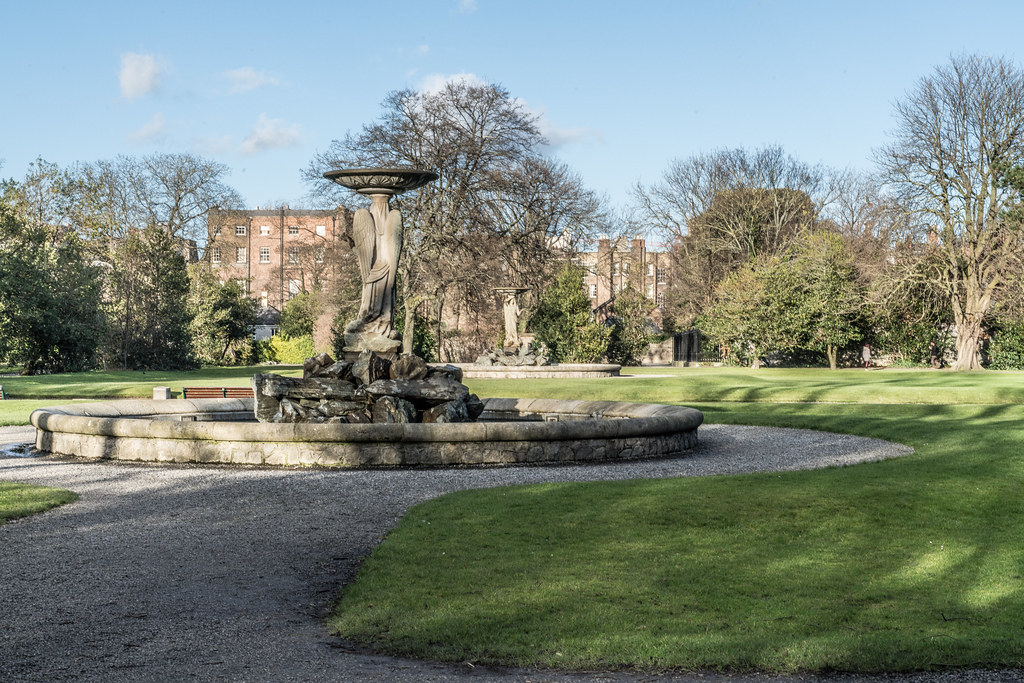IVEAGH GARDENS
The Iveagh Gardens are among the finest and least known of Dublin's parks and gardens.They were designed by Ninian Niven, in 1865, as an intermediate design between the 'French Formal' and the 'English Landscape' styles.
The conservation and restoration of the Gardens commenced in 1995 and to date most of the features have been restored, for example the Maze in Box hedging with a Sundial as a centre piece.
Éamon de Valera, who was then Taoiseach and also Chancellor of University College, Dublin, initiated inquiries with The 2nd Earl of Iveagh as to whether he would sell Iveagh House and gardens complex to the Irish state. On 8 June 1937 this request was declined. However, on 4 May 1939 Lord Iveagh wrote to Éamon de Valera offering the Iveagh complex by way of gift to the nation. Lord Iveagh had been concerned as to the future use of the site, and specified in his letter of offer to Éamon de Valera that the Iveagh Gardens remain "unbuilt on", as a "lung" for Dublin. On 17 May 1939 this gift was accepted by the Government and Éamon de Valera wrote to Rupert, Lord Iveagh. In 1941, the Gardens were re-united with the college buildings of Earlsfort Terrace.
With the growth of student numbers at the university buildings, consideration was given in 1961 to building on the Iveagh Gardens. However, this did not occur and the university moved instead to Belfield thereby saving the gardens.
Last year a petition headed ‘Save The Iveagh Gardens’, which says its aim is to “stop building in The Iveagh Gardens from going ahead” attracted more than 10,000 signatures in less than a week. The petition claimed that part of the east side of the park “will be replaced with a science museum, a plaza, concrete ramps and street lighting” and to facilitate this “they will demolish the 140-year-old wall, fell the magnificent old trees and destroy wildlife habitat”. The OPW, which secured planning permission to build a science centre at the neighbouring National Concert Hall said “no part of it is to be built on the Iveagh Gardens.” According to the OPW the trees in the area had “self seeded” and were “not part of the original landscape design”. In defence of their plans the OPW said "It was only at the end on the 19th century that Earlsfort Terrace was separated from the Iveagh Gardens by the building of a security wall to separate Iveagh Gardens from the newly established University buildings on the Earlsfort Terrace”.
The conservation and restoration of the Gardens commenced in 1995 and to date most of the features have been restored, for example the Maze in Box hedging with a Sundial as a centre piece.
Éamon de Valera, who was then Taoiseach and also Chancellor of University College, Dublin, initiated inquiries with The 2nd Earl of Iveagh as to whether he would sell Iveagh House and gardens complex to the Irish state. On 8 June 1937 this request was declined. However, on 4 May 1939 Lord Iveagh wrote to Éamon de Valera offering the Iveagh complex by way of gift to the nation. Lord Iveagh had been concerned as to the future use of the site, and specified in his letter of offer to Éamon de Valera that the Iveagh Gardens remain "unbuilt on", as a "lung" for Dublin. On 17 May 1939 this gift was accepted by the Government and Éamon de Valera wrote to Rupert, Lord Iveagh. In 1941, the Gardens were re-united with the college buildings of Earlsfort Terrace.
With the growth of student numbers at the university buildings, consideration was given in 1961 to building on the Iveagh Gardens. However, this did not occur and the university moved instead to Belfield thereby saving the gardens.
Last year a petition headed ‘Save The Iveagh Gardens’, which says its aim is to “stop building in The Iveagh Gardens from going ahead” attracted more than 10,000 signatures in less than a week. The petition claimed that part of the east side of the park “will be replaced with a science museum, a plaza, concrete ramps and street lighting” and to facilitate this “they will demolish the 140-year-old wall, fell the magnificent old trees and destroy wildlife habitat”. The OPW, which secured planning permission to build a science centre at the neighbouring National Concert Hall said “no part of it is to be built on the Iveagh Gardens.” According to the OPW the trees in the area had “self seeded” and were “not part of the original landscape design”. In defence of their plans the OPW said "It was only at the end on the 19th century that Earlsfort Terrace was separated from the Iveagh Gardens by the building of a security wall to separate Iveagh Gardens from the newly established University buildings on the Earlsfort Terrace”.
-

IVEAGH GARDENS 001
-

IVEAGH GARDENS 002
-

IVEAGH GARDENS 003
-

IVEAGH GARDENS 004
-

IVEAGH GARDENS 005
-

IVEAGH GARDENS 006
-

IVEAGH GARDENS 007
-

IVEAGH GARDENS 008
-

IVEAGH GARDENS 009
-

IVEAGH GARDENS 010
-

IVEAGH GARDENS 011
-

IVEAGH GARDENS 012
-

IVEAGH GARDENS 013
-

IVEAGH GARDENS 014
-

IVEAGH GARDENS 015
-

IVEAGH GARDENS 016
















